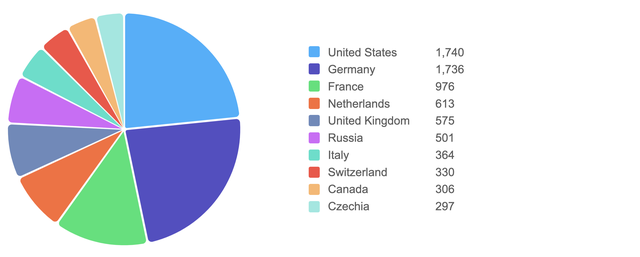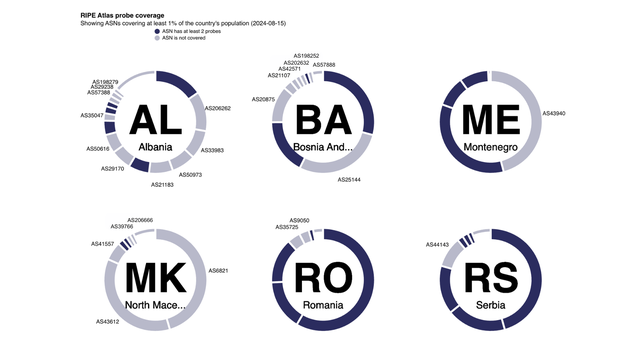With a limited supply of hardware probes and thousands of networks yet to be covered, how do we prioritise the applications to host probes? In this article, we explain our hardware probe distribution strategy to improve RIPE Atlas’s global coverage.
RIPE Atlas is quite unlike other Internet measurement tools. Its 12,000 plus distributed probes provide visibility into networks from thousands of different vantage points, making it a valuable tool for many different use cases. Network operators typically have excellent visibility into what’s going on within their own network, but might not be able to get insights into problems outside their network. RIPE Atlas can help provide that 'view from the outside'. CDNs and tier 1 networks can get a better understanding of their reachability in a region, while researchers and governments can get a birds eye view of the overall resilience of networks.
As we continue to develop RIPE Atlas, and as more users discover how useful it can be, we often get requests for hardware probes. With the number of requests outstripping the availability of probes, we are often obliged to decline applications for hardware probes. Therefore, it’s important to share the considerations that we weigh when distributing hardware probes including the kind of network, its location and number of end users.
We would like to emphasise here that anyone can install a software probe, RIPE Atlas remains an open platform!
End user networks
RIPE Atlas has many different use cases. Deploying RIPE Atlas probes in data centres helps monitor connectivity, while those in content delivery networks (CDNs) offer insights into latency and content distribution. Probes at Internet Exchange Points (IXPs) provide valuable information on inter-network connectivity and understanding whether traffic is kept local for a country.
We would love to get more insights into CDNs and IXPs. However, they are also more likely to have the capability of hosting RIPE Atlas Anchors or software probes, and we encourage them to do so rather than requesting hardware probes.
The majority of RIPE Atlas probes are hosted in end user networks, providing crucial insights into the state of routing from the user perspective. This helps understand network performance, latency, and packet loss, directly reflecting the end-user experience. The data collected aids in troubleshooting and optimising network services to enhance user satisfaction. This is why our hardware probe distribution strategy currently prioritises eyeball networks.
More isn’t necessarily better
A quick look at the RIPE Atlas probe coverage map shows the density of RIPE Atlas coverage in Europe, and chiefly the western European countries. Part of this is because of the RIPE NCC’s presence and the generous probe handouts in the early days of RIPE Atlas.
Having more probes in well-covered parts of the global Internet might benefit individual probe hosts, but doesn’t necessarily provide a lot of additional insights to RIPE Atlas users as a whole. If five probes in an area provide you with very similar data, you’re probably not going to learn much more from having a sixth probe one street further up.

So for everyone in areas where you see fairly dense probe coverage, it would be quite reasonable to assume that your application for a hardware probe might not be accepted.
You can install a software version of a RIPE Atlas probe if you cannot get a hardware probe.

Reducing blind spots
What is clear, though, is that improved visibility across networks can help reduce bias in measurements, something that has been discussed in recent research. Another is that network operators have less visibility into many networks in some areas with the fastest-growing economies and Internet users. Nigeria comes to mind as a notable example, we have only two RIPE Atlas probes in the country with the largest population (216 million people) and economy on the African continent. There are several countries into which we have very low to no visibility at all, and more effort is needed to reach out to the Internet technical communities in these regions. In our own service region, we have lower coverage in Central Asia and the Caucasus, the Middle East and parts of South East Europe.
Having this sort of visibility would help understand Internet behaviour during outages, resilience and recovery and much more.
Of course political and geographic boundaries are not identical with Internet topography. Therefore, our goal is to cover as many diverse networks as possible. A country with many different networks might need many more probes rather than those with state monopolies.
Our approach
Our current approach now is to generate a ranked list of the ASNs consisting of the top eyeball networks in a country, using data from APNIC. The higher the population they serve, the higher up they go on our priority list. With this preliminary triage, we aim to cover at least the top eyeball networks in each country, or those used by a sizeable number of inhabitants. We often share our target ASN lists before we attend NOGs or other events.
If you think there is a different way that we should prioritise our target networks, please let us know in the comments, on the RIPE Atlas mailing list, or on the forum. We will keep reviewing and adjusting our criteria.

Focused outreach with NOGs is a really helpful way to get probes in the right places, as NOG events let us engage with network operators directly. And of course, we continue to be very grateful for the active support of RIPE Atlas ambassadors from all over the world. Our ambassadors volunteer their time to explain the benefits of using RIPE Atlas to operators and to encourage them to host probes in areas with little to no visibility. So if you operate a network in one of our “most-wanted” ASNs, we encourage you to reach out to us or one of our ambassadors. Please keep in mind that we face limitations while shipping probes to certain countries e.g. those under sanctions or those to which we face recurring customs or deliverability issues.
Choices, choices
In 1980, Bill Gates famously envisioned a Microsoft computer in every home and on every desk. In a similar vein, in an ideal world, we would like to have at least one, perhaps more, RIPE Atlas probes in every ASN and every country. Unless we have a generous billionaire supporting this project, we are unlikely to be able to provide 72,000 probes, replace them when they reach their end of life, and further, fund the supporting infrastructure and storage of the astronomical amounts of data generated. If you are a generous billionaire, or even a small organisation, who would like to sponsor RIPE Atlas, please do take a look at this page.
In the meantime, we rely on our generous sponsors. The sponsorship we receive determines the number of hardware probes that we can order. Global supply chain issues and component shortages following the pandemic have also impacted our supply of probes. With a limited supply, we need to make smarter choices. This is why we encourage everyone who has the ability to use software probes to please apply for one. You can also build your own version of a hardware probe, as demoed in this video.
By being more strategic in how we distribute probes, we hope to continue to provide improved insights so that everyone benefits.





Comments 0
The comments section is closed for articles published more than a year ago. If you'd like to inform us of any issues, please contact us.